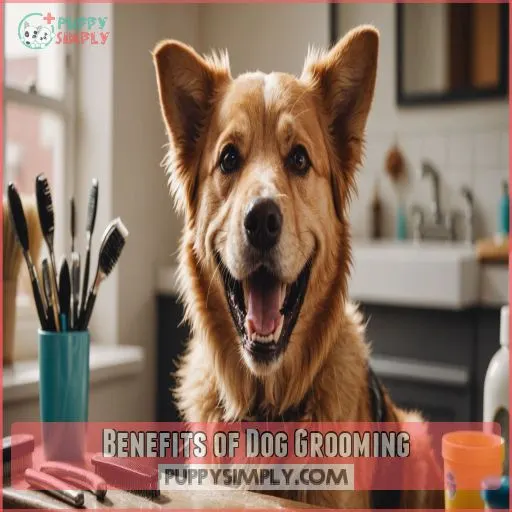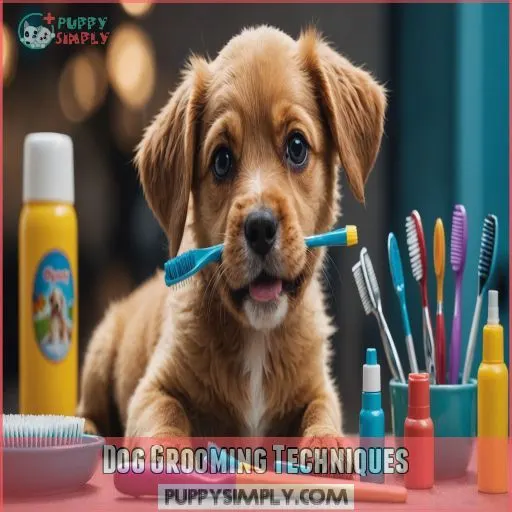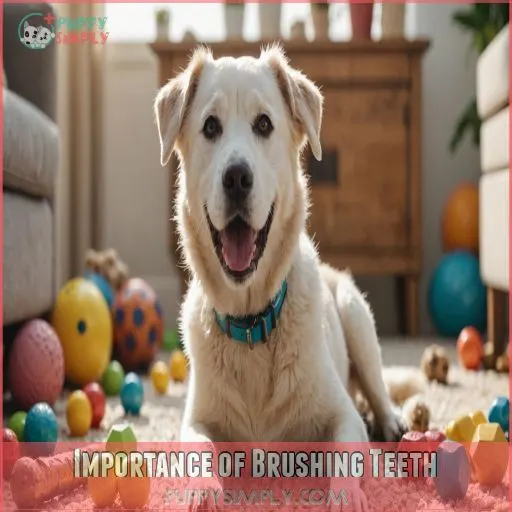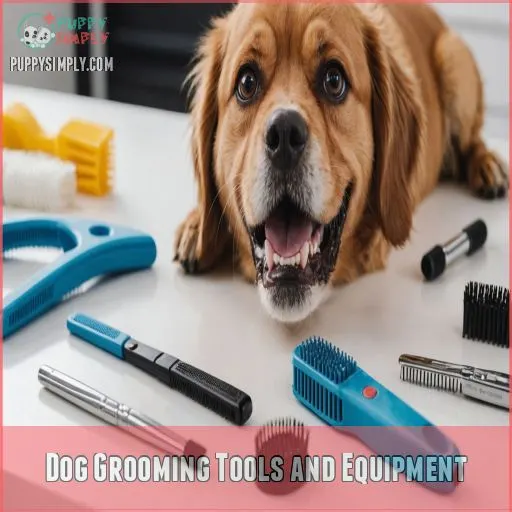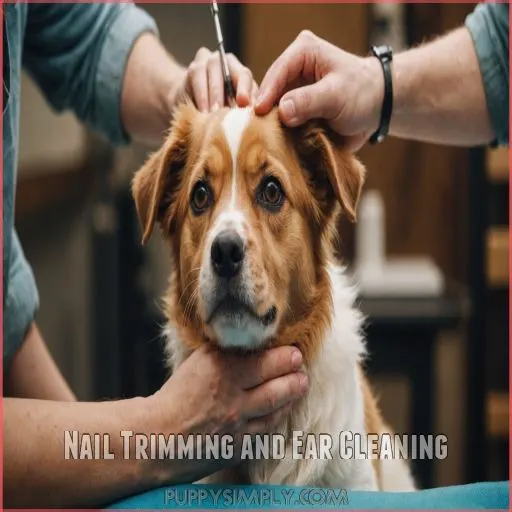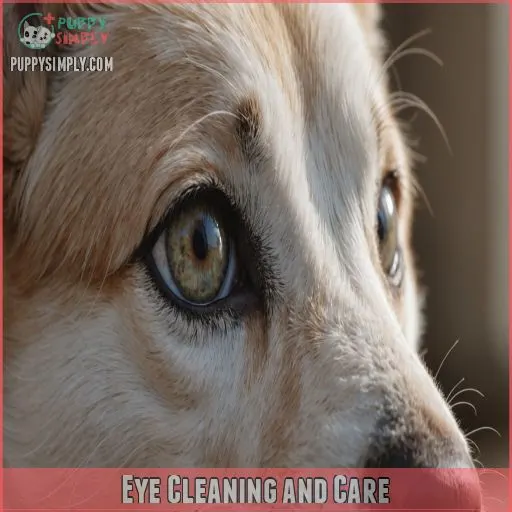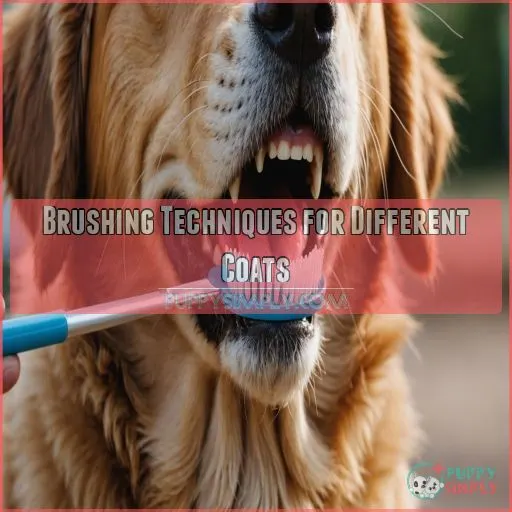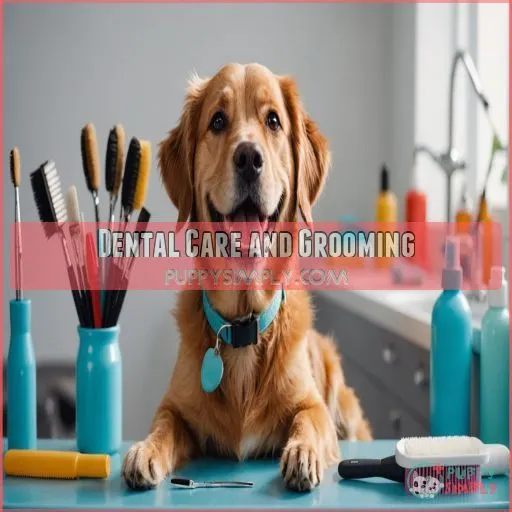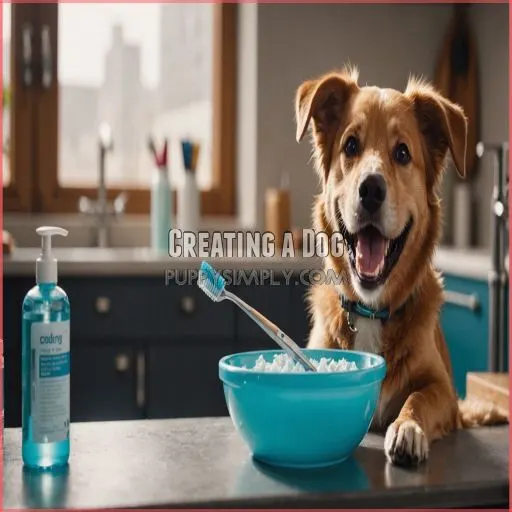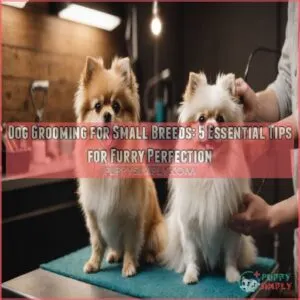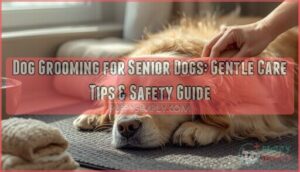This site is supported by our readers. We may earn a commission, at no cost to you, if you purchase through links.
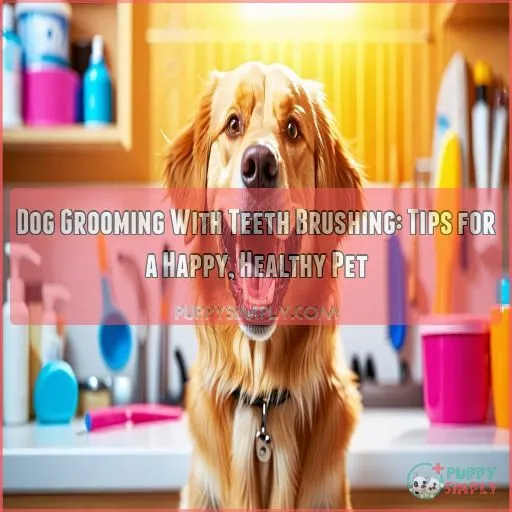
Teeth brushing fights plaque and bad breath, because no dog owner wants a smelly snuggle buddy. Use dog-friendly toothpaste and a special toothbrush; you’ll want to avoid any minty mishaps!
Keeping up with these routines boosts your dog’s confidence and even strengthens your bond. Plus, you’ll catch any sneaky health issues early.
Ready for more tips on keeping Fido fabulous? Stick around—you might just discover a new grooming trick or two to make your pup a smelly snuggle buddy and have sneaky health issues.
Table Of Contents
- Key Takeaways
- Benefits of Dog Grooming
- Dog Grooming Techniques
- Importance of Brushing Teeth
- Dog Grooming Tools and Equipment
- Shedding and Skin Problems
- Nail Trimming and Ear Cleaning
- Eye Cleaning and Care
- Brushing Techniques for Different Coats
- Dental Care and Grooming
- Creating a Dog
- Frequently Asked Questions (FAQs)
- Is brushing teeth grooming?
- Do vets recommend brushing dogs teeth?
- What is back brushing in dog grooming?
- Can I brush my dogs teeth with a tooth brush?
- How often should I bathe my dog?
- What are the signs of dental disease in dogs?
- How can I make nail trimming less stressful?
- What are the best ways to reduce shedding?
- How can I tell if my dog has skin allergies?
- Conclusion
Key Takeaways
- Regular grooming, including teeth brushing, isn’t just about looks—it’s key to your dog’s health and happiness. Think of it as a spa day that also catches sneaky health issues early and keeps your dog’s coat shining like a new penny.
- You’re not just cleaning when you groom; you’re also boosting your pup’s mood and strengthening your bond. It’s like a heart-to-heart chat but with slobbery kisses and wagging tails.
- Brushing your dog’s teeth helps prevent plaque and smelly breath, so you can enjoy those wake-up kisses without holding your nose. A pup’s smile stays bright and healthy-looking.
- The right tools make all the difference. Use brushes, nail clippers, and dog-friendly toothpaste, like those recommended for Yorkie grooming, to keep your furry friend comfortable and looking their best
. Regular grooming turns Cocker Spaniel shedding seasons into less of a hairy battlefield managing heavy shedding
.
Benefits of Dog Grooming
Grooming your dog isn’t just about keeping them looking spiffy; it’s a way to boost their health and mood.
Plus, it’s a great chance to catch any sneaky health issues early, so you’re not taken by surprise later on, similar to the effect of your morning coffee kick.
Improved Physical Health
Dog grooming isn’t just about keeping your furry friend looking good.
When you brush and bathe regularly, you’re tackling weight management and boosting joint health.
This routine also helps with skin allergies and dental hygiene, keeping dog breath at bay.
Your pup stays healthier, and you nip minor issues in the bud before they escalate.
Enhanced Mental Well-being
Looking to boost your pup’s mood?
Regular grooming isn’t just about physical health; it’s a mental pick-me-up too. Your dog will prance like a champion, shedding stress and anxiety, and building confidence with every brush stroke.
Plus, canine grooming and dog teeth brushing offer playful exercises in positive reinforcement. It’s like therapy, but with slobbery kisses!
Stronger Bond Between Dog and Owner
Grooming isn’t just about looks; it’s a trust-building exercise that enhances your dog’s mental well-being and strengthens your bond.
By incorporating grooming into your daily routine, including activities such as brushing their teeth with a VOHC-approved dog toothbrush, you create shared activities that boost trust and improve dog training.
Regular brushing also helps to prevent periodontal disease, which affects over 80% of dogs over 3 years old.
It’s like having a heart-to-heart with your furry friend during playtime, transforming mundane tasks into moments of connection.
Early Detection of Health Issues
Your dog’s grooming routine is more than just a pretty coat – it’s a vital way to catch health issues early.
By regularly brushing and bathing, you’ll become familiar with your pup’s skin and coat, allowing you to spot any concerning changes like rashes, lumps, or dry patches.
This early detection can lead to quicker treatment and a healthier, happier dog.
Dog Grooming Techniques
Taking care of your dog’s grooming needs can feel a bit like running a doggie spa, but with less cucumber water and more dog hair.
Whether you’re brushing, shampooing, trimming nails, or cleaning ears, regular sessions keep your dog looking sharp and feeling great.
Brushing Methods for Different Coat Types
Imagine tackling your dog’s coat like a pro!
Different coat types need different brushes:
- Smooth Coats: Use bristle brushes to manage shedding and spread natural oils.
- Curly Coats: Soft slicker brushes prevent mats and keep curls bouncy.
- Double Coats: Opt for slicker brushes; focus on areas like "pantaloons" for mat prevention.
Your pet will thank you!
Bathing and Shampooing Techniques
After choosing the right brush, tackle bathing with a splash. Use lukewarm water and dog shampoo—human shampoos are off-limits due to different pH levels (Source).
Lather up like you’re at a doggy spa day! Rinse well and dry using towels.
Adjust the frequency based on your pup’s coat; some need more baths, others less, depending on their specific needs for a doggy spa day.
Nail Trimming and Ear Cleaning Procedures
Bath time isn’t the only part of grooming your dog needs. When trimming nails, keep nail clippers handy for quick trimming and prevent painful experiences. Ear care is just as important; ear cleaning tools can help fend off dog ear infections.
Here’s how to keep your pet pampered:
- Regular nail care
- Avoid hitting the quick
- Inspect for ear infections
- Use gentle cleaning solutions
- Be patient and reassuring
Importance of Regular Grooming Sessions
For your furry friend’s well-being, regular grooming sessions are as essential as toothbrushes to your pearly whites. They offer health benefits, ensuring skin health while controlling shedding. Grooming strengthens your bond and helps in early detection of health issues.
| Benefit | Description |
|---|---|
| Health | Promotes skin health and wellness |
| Bonding | Strengthens owner-pet relationship |
| Early Detection | Spots potential health problems |
| Shedding | Controls loose fur |
| Comfort | Keeps your dog comfortable |
Embrace grooming for a happy pup!
Importance of Brushing Teeth
Just like you wouldn’t skip brushing your own teeth, your dog’s dental care is essential for preventing plaque and tartar buildup.
A fresh breath and healthy gums aren’t just for show—they help keep your pet happy and thriving.
Prevention of Plaque and Tartar Buildup
You may not realize it, but your pup’s dental health is just as important as their coat.
Regular teeth brushing helps prevent plaque and tartar buildup, which can lead to painful gum disease.
Luckily, it’s easy to do at home with the right tools.
Your dog will thank you for keeping their smile bright and healthy!
Reduction of Bad Breath and Gum Disease
Tired of avoiding those furry wake-up kisses because of bad breath? Regular teeth brushing is a game-changer for dental hygiene, reducing bad breath and gum disease while keeping your canine’s health in check.
Grab a dog-friendly toothbrush and paste.
- Freshen your dog’s breath
- Keep those gums healthy
- Save on vet checkups
- Enjoy snuggle time without the stink
Importance of Regular Dental Check-ups
Say goodbye to bad breath by understanding gum disease prevention and plaque control.
Regular dental check-ups are key.
They help your furry friend stay wagging and happy, catching sneaky issues like tartar before they cause chaos.
Vet visits aren’t just chores—they’re a crucial part of oral hygiene and overall pet wellness.
Think of them as a spa day for your dog’s grin!
Tips for Brushing Your Dog’s Teeth at Home
Brushing your dog’s teeth is like giving them a little spa day for their mouth. Whether it’s beef or chicken-flavored toothpaste, choose one your furry friend loves.
Use a dog toothbrush designed for their comfort and aim for a brushing frequency of several times a week.
Gentle brushing techniques prevent plaque buildup, promoting pet hygiene and overall dog care, just like caring for a Cavapoo’s silky coat
.
Dog Grooming Tools and Equipment
Choosing the right grooming tools is like picking the best outfit for your dog; it makes all the difference.
You’ll need brushes, nail clippers, and special toothbrushes to keep your furry friend looking sharp and feeling great.
Types of Brushes and Combs
Choosing the right dog grooming tools starts with understanding brush types, like the must-have brushes for Cavapoos
.
Slicker brushes tackle tangles in double coats, while pin brushes add shine. Bristle brushes work wonders on double coats, acting like magic brooms against dirt.
Combs often play sidekick, essential for those perfect finishes.
Knowing your dog’s coat type helps you find the perfect brush for their unique needs, such as a pin brush or bristle brush, and regular brushing can help distribute natural oils, keeping your dog’s coat moisturized and shiny.
Remember, choosing the right tool makes sure your furry friend looks fabulous during dog teeth brushing.
Nail Clippers and Dremel Grinders
After choosing the perfect brush, let’s talk dog nail care.
Clippers, quick and efficient, are great for restless pups but require care to avoid the quick.
Dremel grinders smooth nails sans sharp edges—ideal for the wiggly type.
Balance your routine with regular trimming, ensuring safety and comfort for your furry friend.
Styptic Pencils and Other First Aid Tools
Got a pup who’s prone to nail mishaps? Keep a styptic pencil handy – it’s a grooming essential for stopping bleeding fast.
Just wet the tip and apply pressure to the cut nail. The benzocaine helps numb the pain too. (Source)
No styptic? Try cornstarch or baking soda – they work in a pinch.
Toothbrushes and Toothpaste for Dogs
Regarding dog grooming, don’t forget about your pup’s pearly whites. Just like with styptic pencils for emergencies, choosing the right dog toothpaste is key.
Look for pet-friendly flavors like poultry or mint to make brushing frequency enjoyable. Avoid human toothpaste as it can lead to tummy troubles.
Opt for top brands or consider homemade mixtures for effective dog teeth brushing.
Shedding and Skin Problems
Ever wonder why your dog’s favorite spot on the couch is covered in fur?
Shedding is normal but can sometimes signal skin problems, so keeping an eye on their coat and skin health is key to a happy, healthy pup.
Causes and Prevention of Excessive Shedding
Excessive dog shedding can drive you up the wall.
Stress, allergies, or an imbalanced diet often lead to this hairy mess.
To prevent it, tailor grooming to your dog’s breed and season, ensuring your pup’s coat is shiny and healthy.
Regular brushing and teeth care keep shedding in check, making your home less like a furry battlefield.
Common Skin Problems in Dogs
A happy, itch-free dog is worth its weight in gold when dealing with skin problems. Flea bites, skin allergies, or those sneaky mange mites might be to blame.
Here’s what you need to watch for:
- Hot spots: Lick, lick, lick!
- Yeast infections: Smells like trouble.
- Dog parasites: Itchy and scratchy show.
Regular dog grooming helps!
Signs and Symptoms of Skin Allergies
You might notice your pup’s scratching like it’s going out of style or constantly licking certain spots.
Keep an eye out for redness, hair loss, or hot spots. These could be signs your friend is dealing with skin allergies, a common doggie dilemma.
Regular dog grooming, including teeth brushing, helps spot these issues early, ensuring your pet stays comfy and healthy.
Treatment Options for Skin Issues
Got a furry friend with skin issues?
Tackle skin allergies and shedding with a mix of topical treatments and dietary changes.
Consider medicated shampoos as part of your dog grooming routine. Veterinary care is essential to pinpoint problems.
Don’t forget dog supplements for that extra oomph. Keep your pooch’s skin healthy, and maybe they’ll stop scooting, too!
Nail Trimming and Ear Cleaning
Keeping your dog’s nails trimmed and ears clean is essential for their comfort and health.
Regular nail trims prevent painful overgrowth, while ear cleaning helps ward off infections.
So don’t skip these grooming essentials!
Importance of Regular Nail Trimming
A tidy nail is a happy tail! Regular nail trimming isn’t just about looks; it’s essential for your dog’s gait and pain prevention.
Long nails can cause gait issues, discomfort, and even infection risks .
By prioritizing paw care, you’re ensuring your furry friend can prance around with ease.
Remember, dog grooming and teeth brushing go hand in hand for overall pet health, especially with proper certified dog grooming training
.
How to Trim Your Dog’s Nails at Home
Trimming your dog’s nails at home can be as easy as pie with the right approach. First, gather nail trimming tools. Understand dog nail anatomy to avoid the sensitive quick.
Here are your quick trimming tips:
- Choose the right clippers.
- Reward with treats after each snip.
- Trim regularly to prevent overgrowth.
- Use styptic powder if needed.
Ear Cleaning Techniques and Tips
Just as a chef needs the right tools, you’ll need the best ear-cleaning tools for your dog’s ears.
Use pet-friendly cleansers and cotton balls, steering clear of tips that act like wrecking balls in sensitive spaces.
A gentle massage warms the cockles of their ears, cleaning debris effectively.
Stick to a regular cleaning frequency for the best dog health and grooming (Source).
Signs of Ear Infections and How to Treat Them
After mastering ear cleaning techniques, keep an eye out for ear infection symptoms like redness, odor, or head shaking.
These can be tell-tale signs your pooch needs a vet visit.
While home remedies might soothe minor issues, a thorough ear cleaning routine and regular wound care practices like using natural shampoos prevent infections
.
Prioritizing dog grooming and dog ear care keeps tails wagging happily.
Eye Cleaning and Care
Your dog’s eyes are like windows to their world, so keeping them clean helps prevent infections and discomfort.
Think of it as a daily face wash for your furry friend, making sure they can see all their favorite things clearly.
Importance of Regular Eye Cleaning
Regular eye cleaning is essential for your dog’s eye health, preventing tear stains, infections, and irritation. By incorporating eye care into your grooming routine, you’ll keep those peepers bright and healthy.
For healthy eyes, look for:
- Clear eyes without discharge.
- Healthy tissue in the surrounding area.
- Less red or inflamed eyes.
- Reduced tear stains visible.
- Happy, comfortable pup, always!
How to Clean Your Dog’s Eyes at Home
To clean your dog’s eyes at home, start by gently wiping away any discharge or debris with a damp, soft cloth. Avoid using soap or harsh chemicals, as these can irritate your pup’s sensitive eyes.
For a deeper clean, try these eye-care tools:
| Tool | Use |
|---|---|
| Saline Solution | Rinse eyes |
| Cotton Balls | Wipe away discharge |
| Warm Compress | Soothe irritation |
| Eye Wipes | Gently cleanse |
Signs of Eye Infections and How to Treat Them
Spotting a dog’s eye infection can be as tricky as finding a needle in a haystack.
Look for eye discharge, redness, watering, or swollen eyelids. Just like regular ear cleaning prevents infections, regular dog grooming and eye cleaning can help spot early signs of eye problems.
Regularly checking for redness or discharge, especially in moist environments prone to yeast overgrowth, can make a big difference in your dog’s health how to clean dog’s ears.
If the third eyelid makes an appearance, it’s time to head to the vet. Treat with antibiotics or drops, ensuring your furry friend’s eyes sparkle like diamonds again.
Keep up with grooming and dog health routines!
Tips for Maintaining Healthy Eyes
Every dog owner knows the drill: eye health is super important!
Keep those peepers sparkling by gently wiping away eye discharge with a moist cotton ball or dog tear stain remover.
Watch for signs of eye irritation or glaucoma, like excessive blinking or changes in discharge.
Regular checks make sure your dog stays bright-eyed, adding a dash of safety to your grooming routine.
Brushing Techniques for Different Coats
When brushing your pup, coat type really matters—whether it’s short, wiry, silky, or curly, each needs a different approach.
Get your grooming game on point with the right techniques to keep your dog’s coat looking fabulous and tangle-free.
Brushing Short, Smooth, or Wiry Coats
After eye cleaning, let’s tackle brushing short, smooth, or wiry coats.
Use the right tools to make your pup’s fur shine like a new penny! Regular brushing keeps their coat healthy, plus it’s bonding time.
Try these:
- Rubber grooming gloves for short, smooth coats
- Soft bristle brushes for smooth coats
- Wire brushes or Slicker brushes for wiry fur
- Weekly brushing for maintaining shine
Brushing Long, Silky, or Curly Coats
Juggling short coats is a breeze, but let’s tackle those long, silky, and curly coats.
You’ll make coat tangles fear your daily brushing skills.
Use detangling tools like a pro and invest in quality hair care products to prevent mats, which will also help you master daily brushing skills.
Your dog will thank you with extra wagging, and maybe some dog scent cuddles—dogs don’t play fetch with messy fur!
Brushing Double Coats and Undercoats
Shifting from silky coats to the rugged double coats, you’ll need specialized tools and techniques.
Embrace the shedding season with confidence!
Use an undercoat rake to:
- Tackle tangles: Prevent matting in your dog’s luxurious undercoat.
- Enhance coat care: Foster healthy skin and hair.
- Increase brushing frequency: Especially during peak shedding waves [^(citation:1)][^(citation:2)].
Tips for Brushing Your Dog’s Coat at Home
Brush your pup’s coat regularly to keep it soft and healthy.
For curly or double-coated breeds, use a slicker brush and metal comb to reach the skin. Focus on problem areas like the ears, legs, and belly.
Finish with a leave-in conditioner to prevent tangles. Grooming doesn’t have to be a hassle – with the right tools and techniques, you can keep your furry friend looking their best!
| Coat Type | Brushing Tool |
|---|---|
| Smooth | Slicker Brush |
| Double | Undercoat Rake |
| Long | Pin Brush |
| Curly | Slicker Brush, Metal Comb |
Dental Care and Grooming
Your dog’s smile needs as much attention as their coat.
Make brushing their teeth a fun ritual alongside grooming.
You’ll tackle bad breath and gum disease, but also sneak in some extra bonding time that keeps their tail wagging.
How to Brush Your Dog’s Teeth at Home
Picture a happy dog with sparkling teeth: a scene straight out of a doggie dream. When choosing a dog toothpaste, you can select from flavors like chicken, beef, or peanut butter, which can make the experience more enjoyable for your dog.
Canine toothpaste is specifically designed to prevent plaque buildup and keep teeth healthy.
Here’s the recipe:
- Use dog toothpaste—never, ever human!
- Select a fitting toothbrush; ideally, one with soft bristles to avoid discomfort or irritation, or even finger brushes work wonders.
- Focus on a gentle brushing technique at a 45-degree angle.
- Establish a brushing frequency; ideally, daily.
Reward your furball with treats or cuddles, ensuring animal welfare through joyful dog-grooming sessions.
Signs of Dental Problems and How to Treat Them
You’ve mastered brushing your dog’s teeth at home, now let’s spot dental problems before they become bigger issues.
Watch for bad breath; it’s more than just post-treat aroma, indicating possible oral infections or gum health issues.
Notice any reluctance to eat, drooling, or visible tartar? Consult your vet for treatment options and keep your pup smiling with proper gum health !
Tips for Maintaining Healthy Teeth and Gums
As you tackle dental problems, maintaining healthy teeth and gums becomes a breeze with the right approach.
Explore dog toothpaste brands and dental chew toys as fun solutions for tartar removal. Home remedies like baking soda help too.
Use proper dental cleaning tools and enjoy dog grooming success. Let’s keep those tails wagging and smiles gleaming!
Creating a Dog
Creating a dog is no small feat, but it’s a rewarding venture brimming with wagging tails and slobbery kisses. Before you jump into dog breeding, consider these important aspects:
- Puppy Training: Start with basic commands to establish a harmonious relationship. Training is your best friend’s foundation!
- Socialization: Introduce your puppy to various environments and people to make sure they’re well-adjusted. It’s like taking them to a paw-ty!
- Nutrition: A well-fed dog is a happy dog. Consult a vet to find the perfect diet. Additionally, designing a pet care station can keep all pet essentials in one place, making feeding times more efficient.
- Vet Care: Regular check-ups catch issues early, like pesky hot spots. It’s like having a superhero cape! Furthermore, keeping a pet first aid kit on hand, as part of your pet care routine, can also help manage potential emergencies.
Remember, dog grooming with teeth brushing and plenty of dog playtime keeps tails wagging all day.
Frequently Asked Questions (FAQs)
Is brushing teeth grooming?
Brushing a dog’s teeth is indeed part of grooming, though it borders on dental care.
Regular brushing helps keep your pup healthy and prevents dental issues.
Just imagine it as a spa day for their mouth!
Do vets recommend brushing dogs teeth?
Vets absolutely recommend brushing your dog’s teeth daily to prevent plaque buildup and periodontal disease.
It’s like magic for their health, even if it takes a bit of patience to make it part of the routine.
What is back brushing in dog grooming?
Back brushing involves brushing against the natural lay of a dog’s coat, lifting fur to remove knots and inspect skin for issues.
Can I brush my dogs teeth with a tooth brush?
You can brush your dog’s teeth with a special dog toothbrush or a very soft baby toothbrush.
It’s important to use pet toothpaste since human toothpaste contains harmful ingredients for dogs.
How often should I bathe my dog?
Imagine your dog transformed into a dirt magnet, but generally, aim for a bath every one to three months.
Adjust based on breed, activity, and smell.
Over-bathing can dry their skin, sticking to this schedule keeps them fresh.
What are the signs of dental disease in dogs?
Spotting dental disease in your dog? Look for bad breath, bleeding gums, or loose teeth.
Also watch out for drooling, blood in their saliva, and changes in eating habits.
Stay proactive to avoid bigger health issues later.
How can I make nail trimming less stressful?
Over 60% of dogs dislike nail trims.
But with positive reinforcement and gradual desensitization, you can make this routine task a breeze.
Start by getting your pup comfy with the nail clippers, then work up to quick, painless trims.
What are the best ways to reduce shedding?
Brushing regularly is key to reducing shedding, especially in shedding seasons.
Use the right brush for your dog’s coat.
Supplement with Omega-3 fatty acids and healthy dog food for a shinier, less-shedding coat.
How can I tell if my dog has skin allergies?
If your dog constantly scratches, bites, or licks, it might’ve skin allergies.
Look for red, flaky skin or sores, especially around the ears and paws.
A vet visit can pinpoint the allergen and guide treatment.
Conclusion
Think dog grooming with teeth brushing is a hassle? Imagine this: a clean, healthy, happy pup with fresh breath and a shiny coat.
It’s worth it! Regular grooming keeps your furry friend feeling great and while also spotting any health issues early.
Plus, it strengthens your bond and turns smelly snuggle sessions into sweet ones. With the right tools and techniques, taking care of your dog’s grooming needs can be easy and rewarding.

